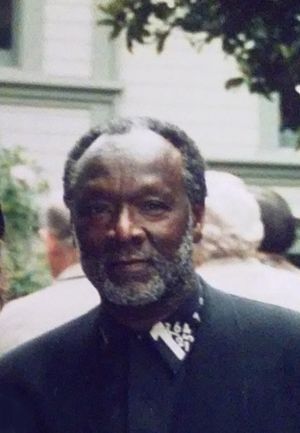Raymond Saunders (artist) facts for kids
Quick facts for kids
Raymond Saunders
|
|
|---|---|

Saunders in 1995
|
|
| Born | 1934 Pittsburgh, Pennsylvania, U.S.
|
| Died | (aged 90) |
| Education |
|
| Known for | Painting |
| Awards |
|
Raymond Saunders (born in 1934, passed away in July 2025) was an American artist. He was famous for his colorful paintings. He often used many different materials in his art. These included drawings, collages, and even words he found. Saunders also created art installations and sculptures.
Contents
Early Life and Art Education
Raymond Saunders was born in Pittsburgh, Pennsylvania, in 1934. He went to public schools there. A special art teacher, Joseph Fitzpatrick, saw his talent. This teacher encouraged Raymond to become an artist.
Raymond studied art at the Carnegie Institute of Technology. He earned his first art degree in 1960. He also studied at other famous art schools. These included the Pennsylvania Academy of the Fine Arts. He received a scholarship to attend. Later, he earned his Master of Fine Arts degree in 1961. This was from the California College of the Arts.
Raymond Saunders' Art Career
Raymond Saunders mostly lived and worked in Oakland, California. He was a respected art professor. He taught painting at the California College of the Arts. He also taught at California State University, East Bay.
Saunders' Unique Painting Style
Raymond Saunders used many different art materials. He is best known for his paintings. His paintings often mixed different types of art together. Sometimes, his art even looked like sculptures. But they always looked good on a flat wall.
His paintings were very expressive. He often added collages to them. These were small pieces of paper he found. He also used chalk to write words. Sometimes, he would cross out these words. These elements added meaning and texture to his art. Even his abstract art told a story. This made his work unique.
Art and Identity
In 1967, Raymond Saunders made an important statement. He said, "black is a color." He believed that art should not be limited by a person's background. He felt that all artists should be seen as artists first.
He said, "I am an artist. I do not believe that art work should be limited or categorized by one's racial background." He wanted his art to be judged on its own merit. Besides his paintings, Saunders wrote a famous pamphlet. It was called Black is a Color. In this writing, he shared his ideas. He argued that the color black should be seen simply as a color in art. He believed it should not be used to limit artists.
Exhibitions of Raymond Saunders' Work
Raymond Saunders' art was shown in many places. His first solo show in New York was in 1962. In the 1960s, it was rare for galleries to show art by Black artists. But Raymond Saunders had a solo show in 1966.
His art was shown all over the world. He had exhibitions in France, Germany, Switzerland, and Japan. His work was also part of important group shows. These included "Thirty Contemporary Black Artists" in San Francisco in 1969.
He was also in a big exhibit called "Afro-American Artists 1800-1969." This show featured many famous artists. His paintings were also displayed at the Whitney Museum in New York. One of his paintings, of boxer Jack Johnson, was even used on a book cover. His art was shown at the San Francisco Museum of Modern Art. It was also featured at the Seattle Art Museum.
Where to Find Raymond Saunders' Art
Raymond Saunders' artworks are kept in many famous museums. These include the Museum of Modern Art in New York. His art is also at the National Gallery of Art. You can find his work at the Philadelphia Museum of Art. The Walker Art Center also has his pieces.
Other places that own his art include the Carnegie Museum of Art. The Metropolitan Museum of Art in New York also has his work. The San Francisco Museum of Modern Art is another important collection. His art is truly valued around the country.
Awards and Recognition
Raymond Saunders received many important awards for his art. In 1964, he won the Rome Prize Fellowship. This allowed him to study art in Rome. He also received a Guggenheim Fellowship in 1976. This special award helps artists create new works. It gave him the freedom to make many more pieces. He often used recycled objects in his art.
He won the National Endowment for the Arts Award twice. These awards are very important for artists in America. They show that his work was highly respected. He also received the Schwabcher Frey Award. This was from the San Francisco Museum of Modern Art.
Curatorial Projects
Raymond Saunders also helped organize art shows. He was a curator. In 1992, he curated an exhibit called "Paris Connections." This show was at the Bomani Gallery in San Francisco. He also organized "American Color: A Late 20th Century Perspective" in 1995.
Personal Life
Raymond Saunders passed away in July 2025. He was 90 years old.

